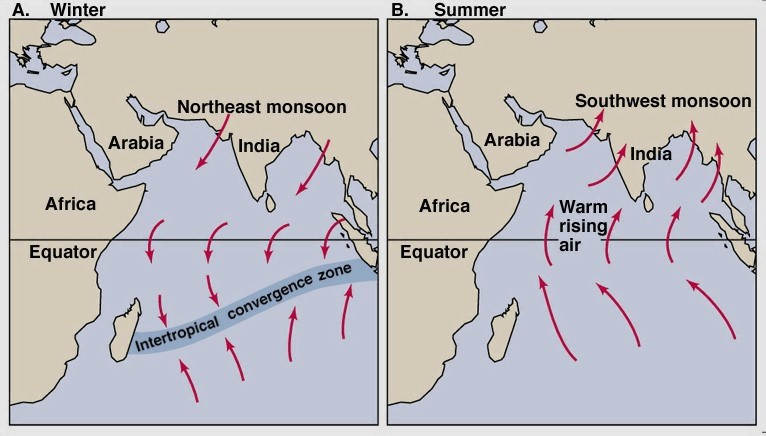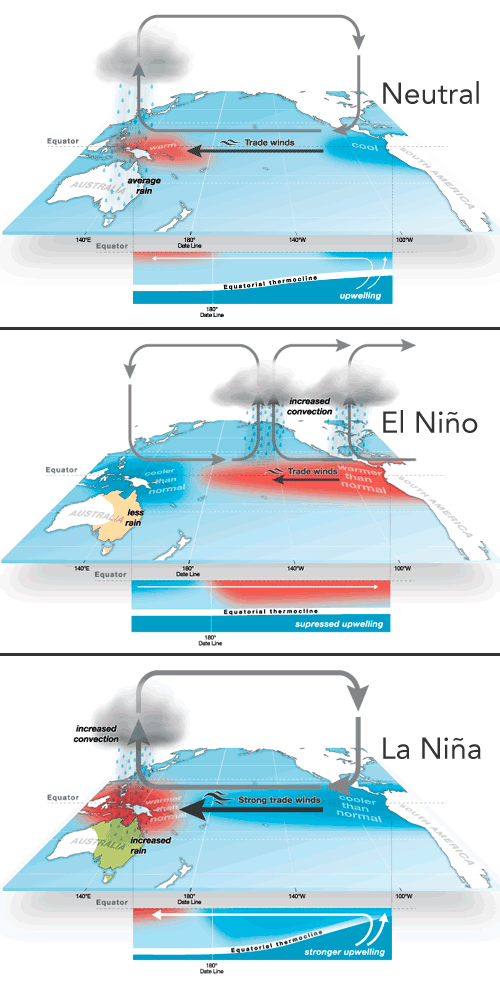Sansad TV Vishesh: Monsoon | 09 May 2024
For prelims: Inter-Tropical Convergence Zone (ITCZ), monsoon, Jet stream, El Nino, La Nina, cholera, typhoid, malaria, UN Framework Convention on Climate Change, flooding, droughts, Long Period Average, Indian Subcontinent, northeast monsoons, southwest monsoons
For mains: Significance of monsoon for the Indian way of Life.
Why in News?
The India Meteorological Department (IMD) has forecasted a probability of above-normal rainfall across the country during the upcoming monsoon season. According to IMD's estimates, there is a 106% likelihood of rainfall exceeding the average between June and September 2024.
What is Monsoon?
- About:
- The term monsoon has been derived from the Arabic word mausin meaning ‘season’.
- It’s experienced in the tropical zone around between 20 ° N and 20 °S.
- The monsoon is characterised by a dual system of seasonal winds, with their flow directed from sea to land during summer and from land to sea during winter.
- Monsoons are unique to regions such as the Indian Subcontinent, Southeast Asia, and parts of Central Western Africa.
- The southwest monsoons originate from an intense low-pressure system formed over the Tibetan plateau.
- The northeast monsoons are linked to high-pressure cells over the Tibetan and Siberian plateaus.
- The southwest monsoons bring substantial rainfall to most regions in India.
- The northeast monsoons primarily affect the southeastern coast of India, including the southern coast of Seemandhra and Tamil Nadu.
- Mechanism of monsoon:
- Onset of Monsoon:
- The Monsoon typically lasts between 100 to 120 days, spanning from early June to mid-September.
- During its onset, the Monsoon experiences a burst, marked by a sudden increase in normal rainfall that persists consistently for several days.
- The earliest showers of the Monsoon are observed on islands, progressing from South to North.
- Upon reaching the southern tip of the Indian peninsula, the Monsoon splits into two branches, the Arabian Sea branch and the Bay of Bengal branch, these branches merge over the north-western part of the Ganga plains.
- Different regions or states welcome the Monsoon at different times, with most of India experiencing it by mid-July. By this time, the Monsoon typically reaches Himachal Pradesh and the remaining parts of India.
- Withdrawal of monsoon:
- The withdrawal of the Monsoon is a gradual process, beginning in the North-Western part of India by early September and completely retreating from the northern half of the Peninsula by mid-October.
- By early December, the Monsoon typically withdraws from the rest of India.
- The rainfall observed during the months of October to December constitutes the northeast monsoon, primarily affecting states like Tamil Nadu, Puducherry, Andhra Pradesh, and Kerala.
- Onset of Monsoon:
What is Long Period Average Rainfall?
The Long Period Average (LPA) of rainfall refers to the average amount of rainfall recorded over a specific region during a particular interval, such as a month or a season, averaged over an extended period of time, typically spanning 30 to 50 years.
- Importance of LPA:
- Forecasting Benchmark: LPA serves as a crucial benchmark for forecasting quantitative rainfall for a specific region and time period.
- By analyzing historical rainfall data over several decades, meteorological agencies can predict expected rainfall patterns more accurately.
- Data Compilation and Updating: Meteorological agencies like the Indian Meteorological Department (IMD) compile and update LPAs periodically, usually every decade, incorporating the latest data from rain gauge stations.
- Smoothing Out Variations: Annual rainfall can vary significantly from year to year due to factors like regional climate variations, El Niño or La Niña events, and climate change-induced extreme weather events.
- LPAs help smooth out these variations, providing a more stable reference for forecasting.
- Forecasting Benchmark: LPA serves as a crucial benchmark for forecasting quantitative rainfall for a specific region and time period.
- Categories of Rainfall Distribution:
- Normal or Near Normal: Normal or Near Normal rainfall refers to precipitation levels that fall within a range of +/-10% of the Long Period Average (LPA), typically ranging between 96-104% of the LPA.
- Below Normal: Rainfall is less than 90% of the LPA, indicating a deficiency in precipitation.
- Above Normal: Rainfall exceeds 104% of the LPA, suggesting above-average precipitation levels.
- Deficient: Rainfall is significantly below 90% of the LPA, indicating a pronounced deficiency in precipitation.
- Excess: Rainfall exceeds 110% of the LPA, indicating unusually high precipitation levels.
What are the Factors Affecting Monsoon?
- Differential Heating and Cooling: Land and water experience differential heating and cooling, resulting in low pressure over land in India and relatively high pressure over seas.
- Shift of the Inter-Tropical Convergence Zone (ITCZ): During the summer months in the northern hemisphere, the Inter-Tropical Convergence Zone (ITCZ) shifts north, pulling the southwest monsoon winds onto the land from the sea.
- ITCZ is a low-pressure belt, caused by the convergence of northeast and southeast trade winds in the area encircling Earth near the Equator.
- High-Pressure Region East of Madagascar: A high-pressure region east of Madagascar, around 20° S over the Indian Ocean, influences the Indian Monsoon.
- Warming of the Tibetan Plateau: During summer, the Tibetan plateau experiences significant warming, leading to strong vertical air flows and the formation of low pressure at around 9 km above sea level.
- Movement of Jet Streams: A major reason for the origin of monsoon is the Jet stream winds that flow in the upper atmosphere of the Himalayas. It has two parts: the Eastern Jet stream and the Western Jet stream.
- Due to the eastern jet stream, the surface hot winds in the northwest part start rising upwards and building low pressure and to fill this void, monsoon winds start moving towards India and this causes the onset of monsoon.
- Effect of Western Ghats: During the monsoon season, the unbroken western ghats act as a barrier to moisture-filled clouds, causing heavy eastward-moving rain-bearing clouds to rise and deposit most of their rain on the windward side.
- El Niño Southern Oscillations (ENSO): El Nino means The Little Boy in Spanish.
- El Nino soon came to describe irregular and intense climate changes rather than just the warming of coastal surface waters.
- ENSO relates to the Southern Oscillation, where a warm ocean current flows past the Peruvian Coast every 2 to 5 years, impacting pressure conditions and resulting in phenomena such as El Niño.
- La Nina Southern Oscillation: La Nina means The Little Girl in Spanish.
- La Nina is caused by a build-up of cooler-than-normal waters in the tropical Pacific, the area of the Pacific Ocean between the Tropic of Cancer and the Tropic of Capricorn.
- La Nina is characterised by lower-than-normal air pressure over the western Pacific, these low-pressure zones contribute to increased rainfall.
- Pressure Variations between Tahiti and Darwin: The difference in pressure between Tahiti (Pacific Ocean) and Darwin in northern Australia is calculated to forecast the intensity of the monsoons.
How Does the Monsoon affect India??
- Positive Impact:
- Agricultural Dependency and Prosperity: Approximately 64% of India's population depends on agriculture for their livelihood, and agriculture relies heavily on the monsoon.
- Timely and adequately distributed rainfall is crucial for agricultural prosperity in India.
- Regions with underdeveloped irrigation systems are particularly vulnerable to adverse effects if the monsoon fails.
- Regional Crop Diversity: Regional variations in monsoon climate contribute to the cultivation of various types of crops in India, leading to a diverse range of food, clothing, and housing styles.
- Water Recharge: Monsoon rains recharge rivers, reservoirs, and groundwater, essential for drinking water supply, irrigation, and hydroelectric power generation.
- Economic Growth: Adequate monsoon rainfall stimulates economic activities, especially in rural areas, by boosting agricultural output, creating employment opportunities, and driving consumer spending.
- Cultural Significance: The monsoon holds cultural significance in India, celebrated through festivals and rituals.
- It is often depicted in art, literature, and music, reflecting its importance in the Indian way of life.
- Agricultural Dependency and Prosperity: Approximately 64% of India's population depends on agriculture for their livelihood, and agriculture relies heavily on the monsoon.
- Negative Impact:
- Flooding and Waterlogging: Heavy rainfall during the monsoon season often leads to flooding and waterlogging in low-lying areas, causing damage to property, infrastructure, and agricultural crops.
- Droughts: Inadequate or erratic rainfall can result in droughts, affecting agricultural productivity, water availability, and livelihoods, particularly in rain-dependent regions.
- Health Risks: Monsoon rains increase the risk of waterborne diseases, such as cholera, typhoid, and malaria, due to contamination of water sources and stagnant water breeding grounds for mosquitoes.
- Infrastructure Damage: Landslides, road washouts, and infrastructure damage are common occurrences during heavy monsoon rains, disrupting transportation networks, communication systems, and essential services.
Way Forward
- Enhanced Water Management: Develop robust strategies to harness and manage monsoon water efficiently for irrigation and power generation, ensuring food security and sustainable development.
- Investment in Forecasting Technology: Allocate resources towards improving monsoon prediction capabilities through advanced technologies and data-driven models to enhance accuracy and reliability in forecasting.
- Climate Adaptation Measures: Implement proactive measures to adapt to climate change impacts, including increased rainfall variability, by investing in resilient infrastructure and sustainable agricultural practices.
- Strengthened International Cooperation: Engage in collaborative efforts at the international level, such as knowledge-sharing and joint research initiatives under frameworks like the UN Framework Convention on Climate Change, to address global climate challenges collectively.
UPSC Civil Services Examination, Previous Year Questions (PYQs)
Prelims
Q. With reference to ‘Indian Ocean Dipole (IOD)’ sometimes mentioned in the news while forecasting Indian monsoon, which of the following statements is/are correct? (2017)
1. IOD phenomenon is characterised by a difference in sea surface temperature between tropical Western Indian Ocean and tropical Eastern Pacific Ocean.
2. An IOD phenomenon can influence an El Nino’s impact on the monsoon.
Select the correct answer using the code given below:
(a) 1 only
(b) 2 only
(c) Both 1 and 2
(d) Neither 1 nor 2
Ans: (b)
Mains
Q. How far do you agree that the behaviour of the Indian monsoon has been changing due to humanizing landscape? Discuss.(2015)


